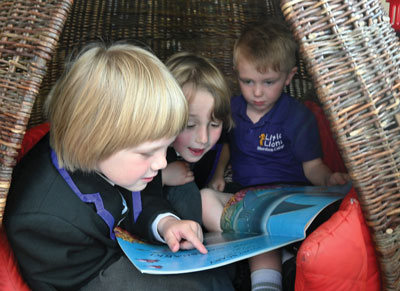
by Jack Esplen, Assistant Principal Juniors
Shoreham College
In a world that has already made the leap from the page to the screen, what is the value of storytelling, and will it really help our children to thrive?
So, you’ve been told this before: early reading is crucial. It has a profound impact on children’s development and their success in later life. You’ve seen evidence too – statistics about how many books, or even words, children should have read before they even start nursery. Have one more fact for your parenting arsenal: it is estimated that a child who is read to daily will have heard 296,660 words by the time they are five years old, compared to just 63,570 words if they are read to once or twice a week.
So yes, reading to your child is important. Storytelling might be even more important – and it helps to understand why.
Children need opportunities to hear stories; they are imperative to help them engage with the world around them and to develop cognitive, social and emotional skills. They give children plots, characters, settings and the chance to fully immerse themselves in worlds and adventures that expand the known experiences at a young age. The pages they have read to them give them an endless library of worlds and characters, prompting a curiosity and the chance to ask thousands of questions as they begin to understand the world around them.
Storytelling lays the foundation for personal, social and emotional development. How many of us think of Disney’s ‘Bambi’ as our first experience of grief, or learnt about the value of true friendship through the lens of Pooh Bear and Piglet? Experiencing the highs and lows of a beloved character’s story, the decisions they make and the pain they endure, enable children to begin to understand what real emotion feels like in a safer, ‘fly-on-wall’ way. Through storytelling and the conversations it sparks, we can teach our children how to communicate, interact and empathise.
Don’t underestimate the impact that quality stories can have on our young people’s ability to problem solve and build resilience. When children follow a character’s journey through challenges and obstacles, they learn that struggles are a natural part of life. The way these characters overcome adversity offers children a road map for how they might face difficulties in their own lives. Whether it’s a hero navigating through conflict, or a character learning from their mistakes, stories allow children to witness failure and triumph, and most importantly, the process in between. This helps them develop a growth mindset, teaching them to see setbacks as opportunities for growth rather than reasons to give up. It is through the act of storytelling that children are able to build both their inner strength and their ability to persevere.
So, in a world dominated by technology and screens, it’s crucial we continue to make space for these timeless traditions that foster emotional intelligence, problem-solving skills, and empathy – essential skills for thriving in today’s complex world.
Please call 01273 592681 to find out more about what Shoreham College can offer you, or to arrange a personal visit at any time of the school year.
www.shorehamcollege.co.uk


















